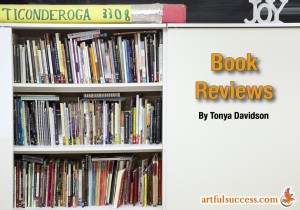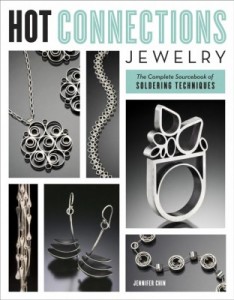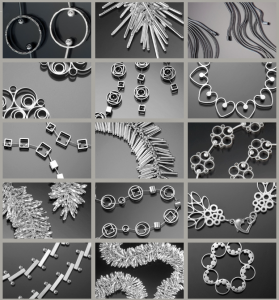
Hot Connections Jewelry: The Complete Sourcebook of Soldering Techniques by Jennifer Chin
This book, published in 2011, is a great addition to my library and I recommend it for a wide variety of soldering projects that are not only fun but beautiful.
I read a few of the Amazon reviews on this book. It was interesting to me that several of them were not favorable. There were several readers who reviewed the book badly because it was “not a comprehensive soldering book”. The thing is that soldering expertise and comprehension comes from doing.
Soldering is like golf. You can’t read how to swing, how to read a lie, etc and be able to go out and play golf. It’s one of those 10,000 hour things to achieve expertise. Soldering is about learning the ebb and flow of the flame, heat, how properties flow and evolve.
I do believe that you want to always try and take a class in person if you can. There is nothing better than having someone show you where to place your hands, torch safety and just a little tender loving guidance on how to do these techniques. That being said, there are people that can learn from books, but this book is probably not that first how-to guide. Maybe after your first class or several.
I don’t think there is a single book out there that can get you to the point of expertise just by reading. So if you approach each book from the point of whether it will excite you to try something new, to incite you to do samples and experiment, or just open your eyes to new possibilities, as an artist that’s success!
I do agree that the sub-title “The Complete Sourcebook of Soldering Techniques” is more than a bit of a stretch. However, even I know that hooky titles are part of marketing. So I neither give them weight or let them decide whether I want to purchase a book.
To an editor of a major publishing house, this probably looked like a complete sourcebook since surprisingly, most of them have no experience with those techniques. As a one-time book author (who never allowed her book to be published for this very reason by one of the biggest art publishers), the author has little to no say-so in the book cover, title or layout of the book itself. So with that taken into consideration, I give it very little weight.
I thought the first chapter: Soldering Basics was well done. The topics: how soldering works, metals, choices for torches, setting up a workspace, and getting started using the torch, were very well laid out and easy to understand. Yes, it doesn’t cover every single method but does provide the basics.
She included helpful charts on metal melting temps along with tips like reclaiming wasted metal. All of it sprinkled between great eye-candy gallery photos that were well done (technique and photography).
The essential fabrication section was pretty straight forward showing sawing, filing, sanding, bending, and riveting. I was secretly hoping for a shared personal technique. What was shown was text book technique. Something you’d learn in academia. Production artists generally have their own down-and-dirty techniques that include great time-savers and interesting methods. I’m particularly interested in those at this point in my level of experience.
Chapter Two also included solder and flux review. I loved that she covered all the different types of pickle but wish she would have also included inexpensive options to jewelry supplier bought pickle. Again there is something to be said for “real working studio” tips on how to save money, do it faster and maybe even “cheat”.
When I buy a book I want to know all their shortcuts, best kept practices and solutions and even a few secrets. Depletion gilding was covered but why not include how to do it not only with a torch but with a kiln. So many metal artists now have kilns, it’s a great way to do batch depletion gilding with lots of pieces or larger pieces!
What I loved most about Jennifer’s book is that she shows projects that are easy plus those that present more challenging soldering tasks. Sometimes you can get bogged down in figuring out how to best approach a project that has a lot of soldering steps. This book does show you how to break down a more complex project and make it doable! However, for beginners you’ll be disappointed as steps are not shown in their entirety, which is common for these types of books.
I can’t recommend enough… self-published books where the author is willing to show you every single step. It’s in the boring simple steps that sometimes the magic occurs. I found this to be a secret of my Master Muse Tutorials. No step left out!
Jennifer Chin’s designs are contemporary and cover a wide range of techniques which will appeal to most. She even includes a section on basic stone setting, mixed-metal, hinges, and more! It’s a keeper for my library. In fact, I found a project I just might try… someday 😉
Leave me a comment and be entered to win a drink on me at Starbucks and a free book from Lark Books!
I’ll pick the winner the first week of May. All comments get an entry April.
Share it on FB or Twitter and get 2 entries each as well! Make sure to tag your posts so we see or they won’t count!
**I pay for shipping to any of the 48 contiguous states.








Thanks for the thoughtful review. I too like to learn the author’s tips and tricks.
Thank you Carole! Glad it was useful 😉
Very good review–It’s also best if a reviewer has personal experience with the craft/art beng shown. No soldering teacher or book that I have consulted have addressed 2 major issues: Torch size for a hobbyist/small business artist. The Smith Little torch is marketed widely to this demographic, but it is not quite big enough for major annealing or sizable thick pieces which is where many metal clay beginners start. What are other brands and costs? Issue # 2 is set up. That boils down to experience, but everybody needs to add a bail or a 20 ga. wire to an odd shape of earring. A guide would be nice.
Hi Anne,
Thanks for your comment! I do agree that usually the actually torching or firing equipment is usually never fully addressed in an appropriate manner in a book. I think it’s because of liability.
I do think this book does a fairly good job addressing torches. However I would disagree with the author that a beginner should start with a mini torch or butane torch for soldering. It’s actually the hardest way to learn to solder in my opinion, for everything that you mentioned, plus just learning what heat does when applied to metal. There is a dance in learning how to bath the metal in heat and how solder flows toward that heat.
I love my Smith Acetylene Torch! I do own the mini torch and several butane torches, and they all have their uses, but not for basic soldering tasks.
I agree that the most “obvious” and basic techniques for some, are not obvious for others. This is why with the Master Muse Tutorials the artists had to include every step. Nothing could be assumed that the reader would understand or know how to do it. If you showed a bail you taught it.
Now if I could just find time to format all of them. Those projects keep getting put on the back burner! They really are the best! The artists are so thorough and informative!
What kind of guide, in more detail, would you like to see available on the market?
Thanks for your support!
-Tonya